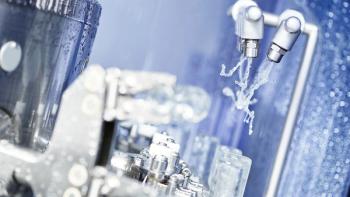
- BioPharm International-01-01-2005
- Volume 18
- Issue 1
Pleated Membrane Filters Improve Process Economics
The drive to develop better, faster, and smaller - in other words, more efficient - products is a universal trend in the modern world. This trend has profoundly impacted many industries from microelectronics to packaging equipment. In the biopharmaceutical industry, the need to speed and simplify the long and complex drug manufacturing processes brings additional challenges, such as meeting regulatory requirements.
The drive to develop better, faster, and smaller — in other words, more efficient — products is a universal trend in the modern world. This trend has profoundly impacted many industries from microelectronics to packaging equipment. In the biopharmaceutical industry, the need to speed and simplify the long and complex drug manufacturing processes brings additional challenges, such as meeting regulatory requirements.
Monica Cardona
Biopharmaceutical filtration is one area in which significant strides have been made in the better, faster, and smaller paradigm. Since most steps in biopharmaceutical manufacturing involve some form of filtration, innovations in this area can significantly compress the time to manufacture modern biological products, including biotechnology, blood products, and vaccines. New filter designs have contributed to faster flow rates, smaller filter and housing sizes, improved microorganism and particle retention, longer service life, and broader application. Advances in the speed, size, and performance of new-generation membrane filters translate into significant cost and time savings for biopharmaceutical manufacturers.
ASYMMETRIC CONSTRUCTION IMPROVES CAPACITY
Asymmetric polyethersulfone (PES) membranes have contributed significantly to the performance of new-generation membrane filters. They offer a 3-to-1 average pore-size gradient through the depth of the membrane, resulting in higher porosity and dirt-holding capacity (Figure 1). This gradient captures larger particles in the outer portion of the filter, providing efficient removal of smaller microorganisms and biological haze within the inner parts. Whereas traditional membranes have a homogeneous pore-size distribution, the asymmetric structure with its large void volume is able to capture solids across the entire depth and pore gradient of the membrane, improving total filter capacity.
Figure 1 (Top). Asymmetric Membrane with 3-to-1 Gradient in Average Pore Size, Figure 2 (Middle). Deep-Pleat Design with Increased Surface Area, Figure 3 (Below). Traditional Pleated Filter with Less Surface Area and Non-Uniform Flow
Membrane materials also play a critical role in the advancement of filters for biologic fluids. Compared to other traditional membrane materials, such as polyvinylidene fluoride (PVDF), cellulose esters, and nylon, PES filters have broader pH compatibility, are resistant to gamma radiation, and are easier to wet. Broad pH compatibility is essential given the universal role that bacterial- and particle-reduction filters play in a wide range of applications including fermentation and cell culture, downstream processing, and formulation and filling. PES's hydrophilicity and resistance to gamma irradiation further broaden the scope of applications and sterilization methods with which these filters are compatible. Gamma-radiation resistance is becoming increasingly important as the use of disposable capsule filters pre-sterilized by gamma irradiation grows. Since not all PES filter membranes are gamma irradiation resistant, it is important to consider this characteristic when selecting a filter.
Table 1. Economic Benefits of New Generation Filters with 10 in. Modules
Filter integrity tests provide another measure of performance. Bacterial-reduction filters, as well as sterilizing-grade filters, must be 100% integrity testable with a forward flow test. This test confirms that the filter is operating to the supplier's specifications. In the case of a bacterial-reduction filter with asymmetric construction and deep-pleat design, the integrity test correlates to titer reductions in excess of 1 x 106 when challenged with aqueous suspensions of Brevundimonas diminuta.
NEW DEEP PLEAT DESIGN MAXIMIZES SERVICE LIFE
In the race to make products better, faster, and smaller, longevity cannot be forgotten. Today's cars are expected to breeze past 100,000 miles. The same can be said for filters in terms of total throughput of process fluid. Of all the ways to improve a product, size reduction is possibly the most challenging. The challenge for semiconductor companies is to fit more circuits on a chip, whereas the objective for biopharmaceutical equipment suppliers is to fit more void volume and filter surface area into a module.
In order to achieve greater filter surface area, the traditional fan-pleat filter has been replaced with a deep-pleat design, which increases the length of the pleats by folding them in a unique way. This required the filter developers to strike a careful balance between filter surface area and flow rate. Determining the amount of filter surface area that could be effectively packed into the module without negatively impacting flow rate was among the great challenges.
Another factor contributing to the increased length of the pleat is a reduction in the size of the core collecting-chamber. This allows the flow path to extend into the space that would normally be reserved for the core, enabling much greater membrane flow and fluid throughput. The core chamber's materials of construction also influence the integrity and usability of the filter.
The combination of a narrow polypropylene core and deep-pleat design enhance mechanical stability and robustness during operation and steam sterilization, which remains the most common method of sterilization. The deep-pleat design allows up to 100% more filter area as diagrammed in Figure 2. Thus, a 10 in. filter can achieve the flow rates of a conventional 20 in. filter. For example, a deep-pleat filter with 1.1 m2 membrane area, a 0.2 μm rating, and efficient bacterial removal can achieve flow rates of greater than 20 L/min. A traditional 10 in. filter, as in Figure 3, with similar removal efficiency, might only provide flow rates of 6-to-10 L/min.
By increasing flow rates, the deep-pleat design also allows biopharmaceutical companies to reduce the number and size of filter assemblies. Smaller filter assemblies mean fewer components to sterilize, test, clean, and validate. They also take up less space on the manufacturing floor. Smaller module sizes are also beneficial in disposable capsule formats, which can be manifolded into complete disposable systems. The size of the module and filling volume influence the economics of biopharmaceutical applications beyond reducing the actual number of filters. A compact module with a small filling volume means that less filtrate will be retained within the filter at the end of the production process. Residual volume can be costly when processing thousands of batches, especially when high-value solutions are used.
Constant-flow filterability tests are used to determine the service life of filters and serve as benchmarks for making better, faster, and smaller products. In order to earn the distinction of better, faster, and smaller, bacterial- and particle-reduction filters must demonstrate superior service in a full range of applications, including biotechnology, blood products, vaccines, formulation and fill, nutrient media, supernatants, protein solutions, biological fluids, and buffers. Asymmetric, deep-pleat membrane filters demonstrate superior performance across all these applications. A comparison between the service life of an asymmetric, deep-pleat Supor UEAV filter and a traditional, symmetric, fan-pleat filter using a constant-flow test for a typical biologic fluid is shown in Figure 4.
Figure 4. Service Life of New Generation vs. Traditional Filters
Deep-pleat design, asymmetric construction, and a narrow, robust core all extend the service life of a bacterial-reduction filter by providing stronger pleat structure, increased filtration area, and better flow distribution. These characteristics also minimize pressure drop, which helps maintain high flow rates and throughputs. Table 1 highlights the economic benefits of an asymmetric membrane filter with deep-pleat design. A few 10-in. modules are shown in Figure 5. In addition to these direct benefits, asymmetric, deep-pleat filters can increase service life of downstream sterilizing-grade filters.
Figure 5. Supor UEAV 0.2 mm Filter
APPLICATION-SPECIFIC BENEFITS
Bacterial- and particle-reduction filters not only provide contaminant removal for a diverse range of biopharmaceutical fluids, but they can also play multiple roles. Filters that demonstrate greater contaminant removal and dirt-holding capacity find wider use within applications. For example, in many biologic applications, advanced bacterial-reduction filters are used for:
- preparation of complex cell-culture media for biotechnological protein and vaccine manufacturing
- protection of the sterile barrier after cell harvest or clarification filtration
- protection of process equipment and final filters in many biotech, blood product, and vaccine intermediate or final biologic product streams
- protection of the final sterilizing-grade filters in formulation and filling applications
- reduction of bacteria in buffers for tangential-flow filtration, diafiltration, process chrom-atography, rinsing, and cleaning fluids
- final filtration of large or complex vaccines that cannot pass a 0.2 μm sterilizing filter with acceptable yields.
Deep-pleat construction with asymmetric PES membranes achieves microorganism retention nearly equal to sterilizing-grade filters, providing effective removal of other potential particulates, aggregates, and contaminants. As a result, these filters provide additional protection for final sterilizing-grade filters.
THE SUM OF ECONOMIC BENEFITS
Flexibility is an important factor to consider when assessing the economic benefits of a bacterial-reduction filter. For example, if space is an issue, a company can use a high-flow, deep-pleat filter to reduce the filter or disposable capsule size without decreasing flow rate. By contrast, if speed is a factor, a company can take advantage of the filter's high flow rates to reduce processing time or increase throughput without changing the size of the assembly. In other instances, such as buffer preparation and filtration of intermediate product, a 0.2 μm bacterial reduction filter that approaches the microorganism-retention capabilities of a sterilizing-grade filter can eliminate the need for subsequent sterilizing filters, thereby simplifying the process and reducing costs. Whatever way a manufacturer chooses to realize the economic benefits of innovative filter technology, the end result is more efficient and faster processing and manufacturing of lifesaving drugs.
Monica Cardona is a Corresponding author and product manager forPall Life Sciences, Western Hemisphere, 2200 Northern Boulevard, East Hills, NY 11548, 516.801.9526,
Christian Martin is a product manager forPall Life Sciences, Europe, Philipp-Reis-Str. 6, 63303 Dreieich, Germany, 49.6103.307.582,
Articles in this issue
almost 21 years ago
Editorial—Take a Hike, Chicken Littlealmost 21 years ago
Final Word: Suppliers Can Help Companies Achieve Speed to Marketalmost 21 years ago
Affinity Chormatography Removes Endotoxinsalmost 21 years ago
Conceptualizing, Making, and Selling the Brandalmost 21 years ago
US Regulation of Plant-made Biopharmaceuticals, Part 1almost 21 years ago
Regulatory Beat: Policy Makers will Focus on Drug Safety and Costs in 2005almost 21 years ago
StreetTalk: Trends to Watch in 2005Newsletter
Stay at the forefront of biopharmaceutical innovation—subscribe to BioPharm International for expert insights on drug development, manufacturing, compliance, and more.





